How does the “Amount Left for Savings & Investments” box work?
January 1, 2023
The Wealth Planner
The only personal finance tool on the market that’s designed to transform your plan into a path to financial independence.
Get The Planner
Join 200,000 other people interested in money, power, culture, and class.
Subscribe Now
Biggest Finance Newsletter for Women
More than 10 million downloads and new episodes every Wednesday.
The Money with Katie Show
Recommended Posts
This feature is intended to guide you as you make your Monthly Contributions Goals for saving and investing, based on your income and planned spending.

Here’s how the number you see in this box is calculated:
-
First, it looks at your post-tax income, including your paycheck contributions to investments.
-
Then, it subtracts any spending you’re planning on doing.
-
The number that’s left is (a) your paycheck contributions to investments, that you’ll enter as “goals” in the table below, and (b) any take-home pay that’s available to save because you haven’t spent it or used it to pay off debt.

Creating Saving & Investments Goals
As you create Monthly Contribution Goals in the “Load Your Accounts, Assets, Liabilities, and Goals” table, the number in the green box will change dynamically. This is intended to help guide you so you know how much left you have to allocate to savings and investments!
If you have an account that you’re actively planning on making more contributions to, check the “Actively Contributing” checkbox so the Planner knows to include it in your monthly tabs.
For example, if you contribute $200 per month to your 401(k), shown on the right, $200 will be removed from the “Amount Left for Savings & Investments” calculation.
Once it goes to $0, you’ve allocated all of your money to spending, saving, or debt payoff.
Note: Your debt payments are accounted for in the “Plan Your Monthly Spending” section. The Debt section in the Liabilities table is intended to help you strategize your payoff (by showing you total interest paid and payoff time, based on payment), as well as so you can enter more information about the debt, like your interest rate and balance owed.
“Wait, why is my number going negative?”
There are a few reasons why the number in the “Amount Left for Savings & Investments” box could be negative:
You’ve planned to spend more than your available post-tax income. Try revisiting your spending plan to make sure there aren’t any errors, or your income, to make sure you haven’t forgotten to include anything.
You’ve created contribution goals that total more than your remaining income. For example, if you only have $1,000 available to allocate to savings and investments but you create goals that equal $1,500 per month, you’ll see -$500 in the box. Sometimes this happens because people are contributing to investments each month with money they already have in savings; e.g., the contributions are not coming from new monthly income. If that’s the case, ignore the negative number and carry on!
Other Useful Reminders
-
Be careful not to cut & pasting cells. This can create #REF errors. (Copy & paste is fine.)
-
Only change data in the white cells. Colored cells have formulas in them to make the Planner work!
-
Avoid adding or deleting rows & columns. (Hiding rows and columns is fine.)
Looking for something?
Search all how-to, essays, and podcast episodes.
Explore
While I love diving into investing- and tax law-related data, I am not a financial professional. This is not financial advice, investing advice, or tax advice. The information on this website is for informational and recreational purposes only. Investment products discussed (ETFs, index funds, etc.) are for illustrative purposes only. It is not a recommendation to buy, sell, or otherwise transact in any of the products mentioned. Do your own due diligence. Past performance does not guarantee future returns.
Money with Katie, LLC.
Terms & Conditions | Privacy Policy
This Site Was Built by Brand Good Time